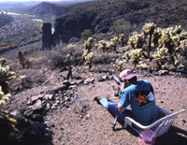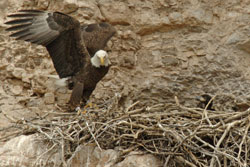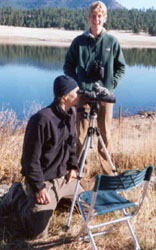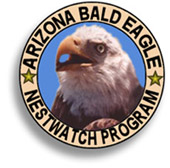Arizona is home to almost the entire population of desert nesting bald eagles in the United States. The eagles live along
rivers and lakes in the upper Sonoran desert. In 1988, less than 30 nesting pairs lived in Arizona. Today, that population
has expanded to 47 nesting pairs in 2014. Protecting this small, unique population of
bald eagles is the equally unique Arizona Bald Eagle Nestwatch Program. See
video or
photos of nestwatchers in action.
The Program
The Arizona Bald Eagle Nestwatch Program is dedicated to the study and conservation of bald eagles in the southwest.
A corps of paid nestwatchers monitors the eagles during their breeding season. As many as 20 trained observers,
in teams of two, work in the field for the entire nesting season collecting data and protecting nest sites from natural
and human disturbances.
Although working conditions can be rugged and some eagle territories are in remote locations, nestwatchers feel privileged to be
a part of the program and develop a special bond with "their" pair of eagles.

Photo by: George Andrejko,
AZ Game and Fish Department
Goals of the Program
The goals of the nestwatch program are:
- To protect the desert nesting bald eagles, their nests and nestlings.
- To collect data on life history, nesting habits and habitat usage of bald eagles.
- To provide information for further conservation efforts for bald eagles.
- To educate the public about bald eagles.
History of the Program
The Arizona Bald Eagle Nestwatch Program began in 1978 when U.S. Forest Service officials in Arizona asked the local
Audubon Society chapter to provide an observer to monitor and protect a single nesting pair of eagles. Today, the Nestwatch Program is coordinated by the Arizona Game and Fish Department with input from the Southwestern Bald Eagle Management
Committee. The committee is represented by 26 different governmental agencies, tribes and private organizations that provide guidance on such matters as which breeding pairs should have nest watchers assigned to them.
Why Watch Bald Eagles?
The most significant problems affecting bald eagles today are human disturbance and loss of habitat. Bald eagles can be found near
water in areas that also are attractive to boaters, hikers, and outdoor enthusiasts. The eagles' survival depends on the quality of
life in these areas. Human presence can have serious consequences. Even passing near a nest may disturb the eagles and cause them
to abandon their eggs. Nestwatchers aid the breeding success of eagles by asking people to refrain from getting too close to nests or disturbing the birds. Nestwatchers also educate the public and solicit cooperation in protecting the future of bald eagles.
A Success Story

The Arizona Bald Eagle Nestwatch Program is the only program of its kind in the United States. Since its modest beginning in 1978,
the program has contributed significantly to the recovery, conservation and growth of this unique population of desert nesting bald eagles.
The Nestwatch Program has provided valuable data on nesting and foraging activities, habitat use and food requirements.
Throughout the years, nestwatchers have also rendered emergency assistance to birds in distress. For example, in 1984, nestwatchers
stopped a bulldozer from toppling a tree with young in the nest. That same year, nestwatchers plucked young eaglets from a nest
that was in the path of floodwaters. These eaglets were placed in the empty nest of another pair of eagles and later fledged successfully.
At another site, some eaglets had fallen from their nests and the nestwatchers put them back into the nest. The nine rescued eaglets
represented sixty percent of the Arizona's eagle production that year. Now, nestwatchers alert AZ Game and Fish Department biologists who perform the rescues. The Nestwatch Program proves that there is no substitute for living with
bald eagles to learn how best to protect them!
What Nestwatchers Do

After a detailed orientation on eagle biology, management, protection, and data collection, each nestwatch team goes to its assigned
area and makes camp. Arizona Game and Fish Department field biologists then spend a few hours showing each team the observation point(s), nest site, camp site, etc.
Once established, the team settles in for the eagle breeding season, which runs from about February until June. Nestwatchers will
stay at the same breeding area throughout the season. However, if a breeding area fails, teams will be moved to another location
based upon which breeding areas are still active and the management needs.
Typically, the nestwatchers work ten days on and four days off. Most of their time is spent watching the nest through a spotting
scope and tracking the eagles with binoculars. Nestwatchers use photos, maps, and grids to record flight paths, perches, feeding
stations, and foraging areas. The Arizona Game and Fish Department does not provide any housing; nestwatchers camp out at the
breeding area and provide their own equipment and food.
Nestwatchers also protect breeding area closures by asking people to stay away from the nests
and reporting any airspace violations by low flying aircraft. Nestwatchers also provide information about bald eagles to the
public.
The Arizona Bald Eagle Nestwatch Program is soliciting contracts for the 2025 breeding season. Nestwatchers will be camping on location for 10 days on, 4 days off work schedule. Contractors must have their own transportation to and from the site (4WD preferred), camping equipment, and binoculars. Salary is $140.00/day. For more information on the Arizona Bald Eagle Nestwatch Program, visit the Arizona Game and Fish Department's web page at
the eagle nestwatch page, call Kenneth Jacobson at (623) 236-7575, or e-mail at baldeagle@azgfd.gov. If you wish to participate in this nationally recognized conservation effort, please send your current resume to baldeagle@azgfd.gov. Once received, an additional questionnaire will be provided to further assist in our selection process. Initial review of applicants will begin Nov. 18, 2024. Additional applications can be accepted until all openings have been filled by qualified individuals.



 The Arizona Bald Eagle Nestwatch Program is the only program of its kind in the United States. Since its modest beginning in 1978,
the program has contributed significantly to the recovery, conservation and growth of this unique population of desert nesting bald eagles.
The Nestwatch Program has provided valuable data on nesting and foraging activities, habitat use and food requirements.
The Arizona Bald Eagle Nestwatch Program is the only program of its kind in the United States. Since its modest beginning in 1978,
the program has contributed significantly to the recovery, conservation and growth of this unique population of desert nesting bald eagles.
The Nestwatch Program has provided valuable data on nesting and foraging activities, habitat use and food requirements. After a detailed orientation on eagle biology, management, protection, and data collection, each nestwatch team goes to its assigned
area and makes camp. Arizona Game and Fish Department field biologists then spend a few hours showing each team the observation point(s), nest site, camp site, etc.
After a detailed orientation on eagle biology, management, protection, and data collection, each nestwatch team goes to its assigned
area and makes camp. Arizona Game and Fish Department field biologists then spend a few hours showing each team the observation point(s), nest site, camp site, etc.